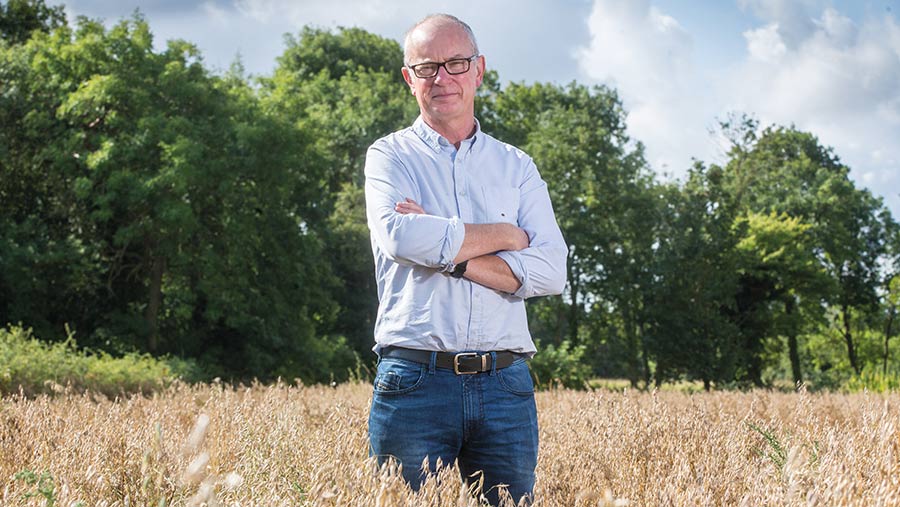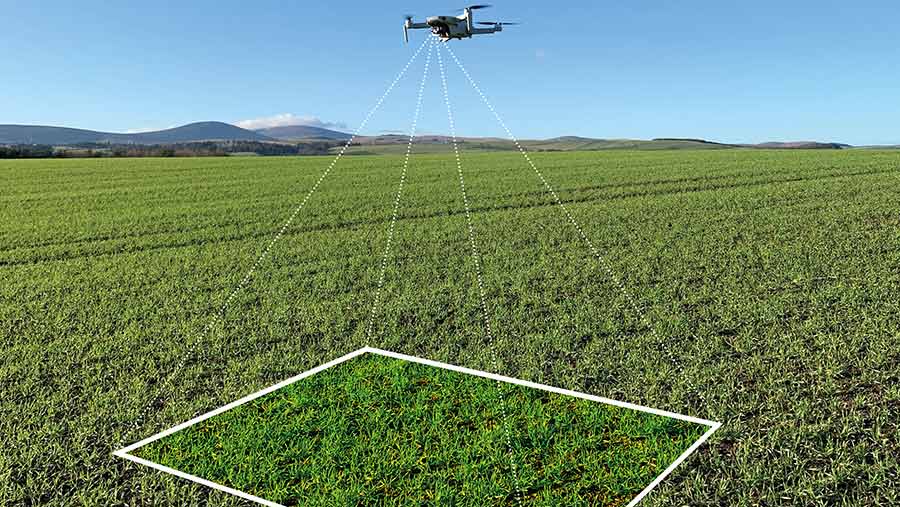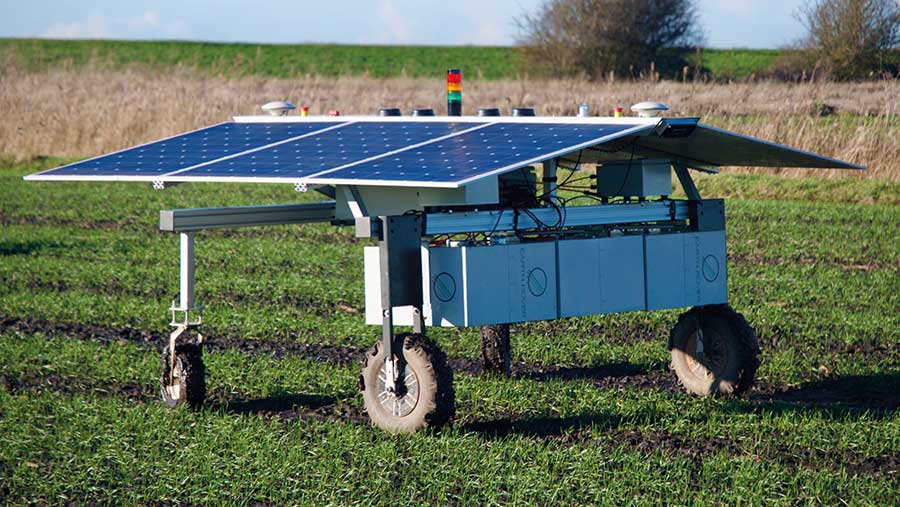Farmer network trials precision farming technology
A 26-strong farmer network set up by Agri-EPI is a key testing bed for emerging start-up precision farming companies and researchers to evaluate and demonstrate their new technologies in a commercial farm situation.
One of these is Suffolk organic farmer John Pawsey, who is trialling two new technologies for the arable side of his 650ha mixed arable and sheep farm.
The results so far highlight both the potential and the challenges for developing and commercialising these technologies.
See also: 3 technologies address arable farming’s biggest challenges
1. Live grain protein analysis
Retrofitted to his Claas Lexion combine, a CropScan box takes grain samples from the grain elevator every 10 seconds, providing real-time protein and nitrogen data using near infrared (NIR) analysis.
“With GPS and the grain data, you’re essentially quality mapping your farm,” Mr Pawsey says.
The first use of the data is to help segregate or blend grain by quality, off the combine and into storage.
He explains: “Having something on the combine that tells you about the average protein by combine tank or trailer load, depending on what you select, means you can direct the trailers from the field into the correct storage bay – helping separate feed wheat from milling wheat.”
That’s working well in real-time, but downloading the data into a usable format for post-harvest analysis has proved more challenging, he says. “The product is still being developed, so there is a way to go.”

John Pawsey © Tim Scrivener
He believes it has huge potential for any farm. “It’s one of those map layers that we are wanting to build up and interrogate alongside yield and soil maps to understand where the value is in our fields at a per-square-metre level.”
Mr Pawsey admits that it has been a bit of a frustrating journey, but is confident it will get there.
Putting it together with other data will bring valuable insights. “For example, we are also recording work rates, so if you have part of a field that yields well and has good quality, but your work rate has slowed by 25%, you need to understand what that cost is.
“We just need a platform to put all the data on and analyse it.”
2. Drone monitoring of trials
Skippy Scout is a mobile app which automatically directs drones to various points in a field, takes images, analyses them for criteria such as crop and weed coverage, crop health and pest damage, and then creates an email field report of the flight.
The system is being used for the first time this season to help analyse field trials at Shimpling Park Farm.
“In the past we haven’t been particularly rigorous at collecting and disseminating data to make best use of the information, so we’re hoping Skippy Scout will help with this,” Mr Pawsey says.

John Pawsey is trialling varying seed rates using the Skippy Scout software to analyse the results © Drone Ag Ltd
One key aim on the farm is to reduce cultivations, for both cost and soil health reasons. But in an organic system, ploughing is necessary to help with weed control.
Over the past few seasons, Mr Pawsey has reduced ploughing to just once in the rotation and started using overwintered green manure crops before spring crops, using a maximum of three shallow cultivations around February to create a seed-bed to keep it economically viable.
“But because of the clay content in our soils, we are finding we are getting more cloddy seed-beds,” he says.
Therefore, he is trialling higher seed rates to help decide whether by doing so, he can lose a cultivation.
“We would be accepting a higher level of field losses because of the cloddiness, but compensating through the higher seed rate.”
The Skippy Scout software is helping analyse the trials, which are varying seed rates from his usual 250 seeds/sq m up to 325 seed/sq m, in increments of 25 seeds/sq m. “We’re looking at seed-bed conditions, emergence and vigour at 16 different points in the trial with the drone.”
Vigour is especially important in an organic crop, as early vigour will help smother weeds, he explains.
“As well as plant numbers, we’re also looking at weed numbers – broad-leaved weeds in a wheat crop, and later at disease. In higher plant populations, some diseases benefit from being in a higher or lower plant population, so what impact will that have on our propensity to get disease?”
Yield and specific weight will also be analysed.
“It’s a known fact that if you have a higher plant population, your specific weight will go down. Can we still hit the market specification of 72kg/hl, while having a higher yield from a higher plant population?”
Most of those initial plant and weed count assessments can be made by a drone in less than an hour, compared with perhaps a whole day doing it manually, Mr Pawsey explains.
While the time saving has been excellent, the initial trials have shown the Skippy Scout weed identification algorithm needs some tweaking, with some incorrect identification, and not returning to exactly the same square metre in the field to take pictures each time, he says.
“There is an error margin there, which they are addressing, so again, it is a journey.”
3. Robotics emerging to help fruit and veg growers
Robotic solutions are emerging to help solve two of the bigger challenges veg and fruit growers are facing – weed control and labour shortages.
Earth Rover is developing a solar-powered ultra-lightweight autonomous machine, which uses a concentrated beam of light to remove weeds in vegetable crops.
Initial trials have been conducted in organic broccoli and lettuce.

Earth Rover’s Claws-6 uses focused light to kill weeds © Earth Rover
“We wanted a solution that didn’t till the soil so we could build organic matter,” says James Brown, co-founder and chief executive of Earth Rover.
The Claws-6 (Concentrated Light Autonomous Weeding and Scouting) robot kills weeds by focusing light on the meristem of the plant, increasing its temperature from 15C to 80C, bursting or disrupting the cells and killing the weed, he explains.
The lightweight platform means it can work in most conditions, even after rain or irrigation when weeds grow the most. The camera system can identify weeds down to 1mm in size.
Weeding is slow, but part of that is by design. “We could weed continuously, but that requires huge extra capacity or alternatively will miss weeds. Our idea is to take out all weeds, with the smaller the weed the less energy it requires.”
Weeding costs are currently higher than chemical, although Mr Brown suggests that when the full cost is calculated, including environmental and greenhouse gas impacts of spraying, it is a different argument.
Another robot developer, Antobot, is developing scouting machines for high-value fruit crops, such as strawberries and apples.
“The robot can first map the field, so we know where all the plants are,” explains Howard Wu, founder and chief executive officer of Antobot. “Secondly, we have developed imaging technology that can characterise fruits.”
In strawberries and apples, that will help growers know how many fruits are growing, their size and weight, and whether they are ripe, Dr Wu says.
“With that information growers can make more optimised logistical decisions around labour and delivery to customers.”
A second robot has been designed to help with the heavy lifting at harvest, but ultimately the firm wants to develop robots that will be able to harvest crops.

